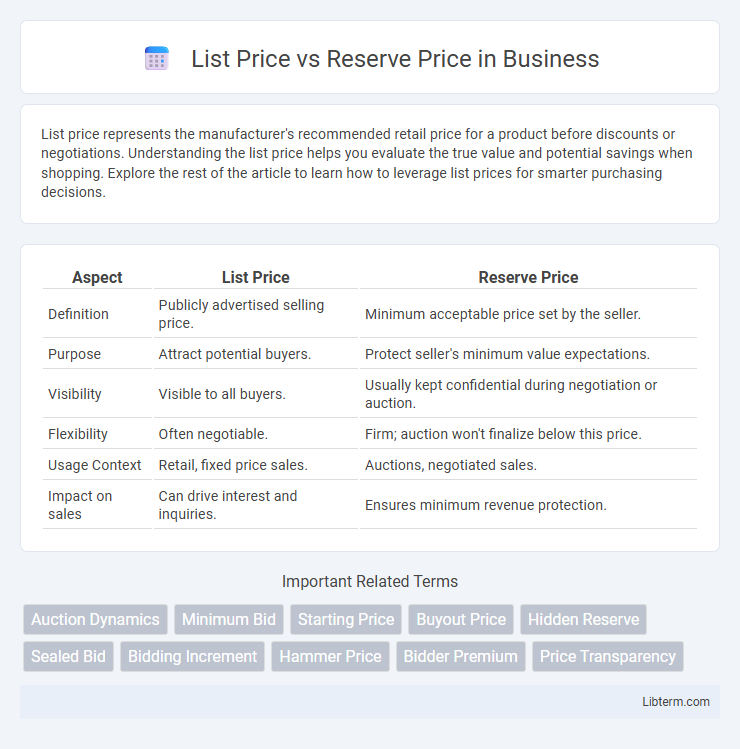List price represents the manufacturer's recommended retail price for a product before discounts or negotiations. Understanding the list price helps you evaluate the true value and potential savings when shopping. Explore the rest of the article to learn how to leverage list prices for smarter purchasing decisions.
Table of Comparison
| Aspect | List Price | Reserve Price |
|---|---|---|
| Definition | Publicly advertised selling price. | Minimum acceptable price set by the seller. |
| Purpose | Attract potential buyers. | Protect seller's minimum value expectations. |
| Visibility | Visible to all buyers. | Usually kept confidential during negotiation or auction. |
| Flexibility | Often negotiable. | Firm; auction won't finalize below this price. |
| Usage Context | Retail, fixed price sales. | Auctions, negotiated sales. |
| Impact on sales | Can drive interest and inquiries. | Ensures minimum revenue protection. |
Introduction to List Price and Reserve Price
List price represents the initial amount set by a seller as the asking price for a product or property, often reflecting market expectations and seller goals. Reserve price is the minimum acceptable bid a seller is willing to accept during an auction, remaining confidential until the reserve is met or exceeded. Understanding the distinction between list price and reserve price is crucial for buyers and sellers to navigate pricing strategies and market dynamics effectively.
Key Differences Between List Price and Reserve Price
The list price is the initial asking price set by the seller, representing the starting point for negotiations or bidding. The reserve price is a hidden minimum amount the seller is willing to accept, often set below the list price to protect against selling below value. While the list price is publicly disclosed, the reserve price remains confidential until bidding meets or exceeds it, ensuring the seller's bottom line is met.
What Is a List Price?
The list price is the initial asking price set by a seller for a product or service, serving as the starting point for negotiations or sales. It represents the retailer's recommended price based on market research, costs, and desired profit margins. Understanding the list price helps buyers evaluate value and compare offers before considering reserve price thresholds in auctions.
What Is a Reserve Price?
A reserve price is the minimum amount a seller is willing to accept for an item during an auction, ensuring the sale only occurs if bidding meets or exceeds this threshold. Unlike the list price, which is a visible asking price or starting bid, the reserve price is often hidden to encourage competitive bidding. Setting a reserve price protects sellers from accepting offers below their desired value while still allowing the auction process to determine the final sale price.
How Sellers Set List Price
Sellers set the list price by analyzing market trends, comparable property values, and current demand to attract potential buyers while maximizing profit. They often collaborate with real estate agents who provide a Competitive Market Analysis (CMA) to determine an optimal listing price that aligns with seller expectations and market conditions. Strategic pricing can create buyer interest and urgency without undervaluing the property before any bidding or reserve price considerations.
Role of Reserve Price in Auctions
The reserve price in auctions acts as the minimum acceptable bid set by the seller, ensuring the item is not sold below a certain value. Unlike the list price, which is often a suggested or starting figure, the reserve price legally protects the seller from undervaluation during the bidding process. This mechanism balances competitive bidding with seller security, directly influencing auction outcomes and final sale prices.
Impact on Buyer Perception
List price sets an initial expectation for buyers, often influencing their perceived value and willingness to engage in bidding or negotiation. Reserve price, hidden or undisclosed, creates uncertainty, as buyers fear the item may not sell if bids do not meet this minimum threshold. This dynamic can either motivate competitive bidding or discourage participation, significantly shaping buyer perception and behavior in auctions or sales processes.
List Price vs. Reserve Price: Pros and Cons
List price sets a transparent, fixed starting point for an auction, attracting buyers with clear expectations but risking undervaluation if set too low. Reserve price offers sellers protection by establishing a minimum acceptable amount, ensuring value retention but potentially deterring bidders if perceived as too high. Balancing list price and reserve price strategies optimizes auction outcomes, merging buyer interest with seller security.
Common Mistakes with Pricing Strategies
Confusing the list price with the reserve price often leads to pricing errors that deter potential buyers or undervalue the auction item. Many sellers mistakenly set the reserve price too high to protect value, causing items to remain unsold despite serious interest at the list price. Understanding the distinct roles--list price as the starting bid and reserve price as the minimum acceptable sale price--ensures optimized pricing strategies and increased auction success rates.
Which Pricing Approach Is Right for You?
Choosing between list price and reserve price depends on your selling goals and market conditions. A list price sets a fixed, public amount that can attract straightforward buyers, ideal for sellers seeking quick, transparent transactions. Reserve price protects sellers by establishing a confidential minimum, better suited for those unwilling to accept less than a certain value, especially in competitive or uncertain markets.
List Price Infographic

 libterm.com
libterm.com